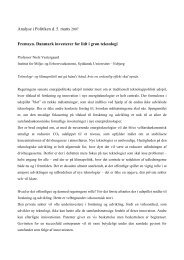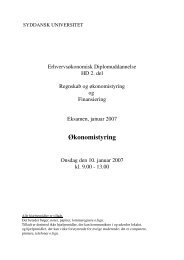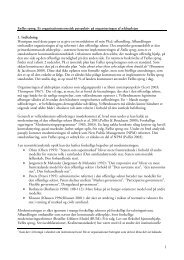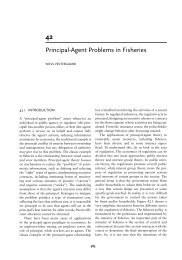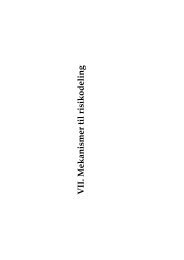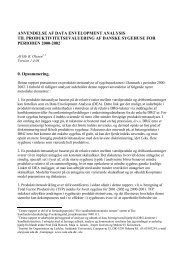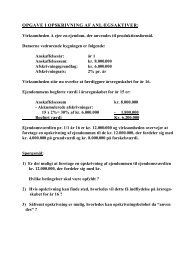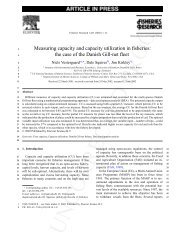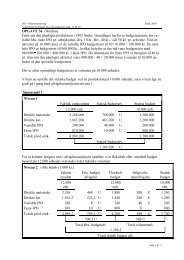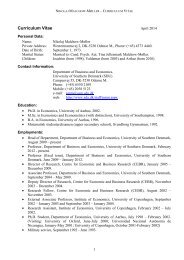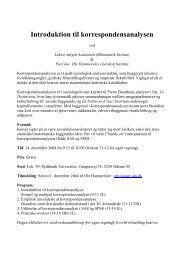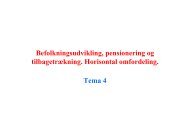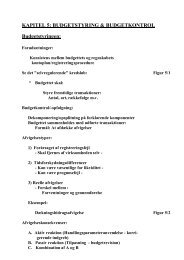Development of Parties and Party Systems in ... - lah@sam.sdu.dk
Development of Parties and Party Systems in ... - lah@sam.sdu.dk
Development of Parties and Party Systems in ... - lah@sam.sdu.dk
- No tags were found...
You also want an ePaper? Increase the reach of your titles
YUMPU automatically turns print PDFs into web optimized ePapers that Google loves.
The formation <strong>of</strong> AWS can be considered as an attempt to <strong>in</strong>stitutionalize the trade unionSolidarity’s control over the right spectre on the political scene. Krzaklewski's proposal that allpolitical groups <strong>in</strong>side AWS should dissolve themselves before the 1997 election <strong>and</strong> after that be aunified political party, did not obta<strong>in</strong> the sufficient support. If such plans had been carried out,many <strong>of</strong> AWS’ later organisational problems may have been avoided. But from the very beg<strong>in</strong>n<strong>in</strong>gAWS was divided both politically <strong>and</strong> <strong>in</strong>stitutionally. Several right w<strong>in</strong>g groups had tried to obta<strong>in</strong>parliamentary representation at the 1993 election, but <strong>in</strong> va<strong>in</strong>. These parties did not accept loos<strong>in</strong>gtheir identity. The support for AWS was tactical, not value, policy or programmatically based. Forthat reason disagreement on the actor level became strik<strong>in</strong>g. In short, AWS can best be consideredas a negative political alliance, established with the explicit aim to jo<strong>in</strong> forces aga<strong>in</strong>st the ”postcommunists”<strong>and</strong> limit the waste <strong>of</strong> votes, however, without a common political platform <strong>and</strong> acommon vision <strong>of</strong> the future <strong>and</strong> without the necessary cohesion <strong>and</strong> loyalty on the leadership level.As regards party <strong>in</strong>stitutionalisation the election alliance AWS appeared as almost copy<strong>in</strong>g ”postcommunist”party alliance SLD, at least formally. The Republic <strong>of</strong> Pol<strong>and</strong>’s Social democratic<strong>Party</strong> (SdRP) constituted the organisational kernel <strong>in</strong> SLD, just as the trade union Solidarity <strong>in</strong>sideAWS. At the time <strong>of</strong> the creation <strong>of</strong> AWS the trade union Solidarity had 1.5 mill members, a figureno other right w<strong>in</strong>g party or organisation was able to match. All other attempts to build up acommon front on the Right aga<strong>in</strong>st the “post-communists” <strong>and</strong> President Aleks<strong>and</strong>er Kwasniewskifailed. As a result <strong>of</strong> that the trade union Solidarity obta<strong>in</strong>ed an almost hegemonic position <strong>in</strong>sideAWS, but ma<strong>in</strong>ly because <strong>of</strong> the lack <strong>of</strong> susta<strong>in</strong>able alternatives.At the foundation the three ma<strong>in</strong> decision centres were• The trade union Solidarity’s leadership, i.e. the ”Komisja Krajowa” <strong>and</strong> the ”Rada Krajowa”• AWS’ political leadership, the coord<strong>in</strong>ation group• AWS’ representation <strong>in</strong> parliamentIn the National Council (”Rada Krajowa”) the votes were weighted equally between the trade unionSolidarity <strong>and</strong> the other groups. The daily work was conducted by a coord<strong>in</strong>at<strong>in</strong>g group (”ZespolKoordynacyjny”). Furthermore, the pr<strong>in</strong>ciple about parity between the trade union <strong>and</strong> the 30 othergroups was applied. The day to day leadership was composed by the chairman <strong>of</strong> the NationalCouncil.The chairman <strong>of</strong> the AWS council was the trade union Solidarity’s leader, i.e. Marian Krzaklewski,thus reflect<strong>in</strong>g the trade union’s strong position. Marian Krzaklewski was both the chairman <strong>of</strong>AWS parliamentary group <strong>and</strong> the trade union Solidarity. The trade union had the decisive word byappo<strong>in</strong>tment <strong>of</strong> c<strong>and</strong>idates for election <strong>in</strong> 1997. The strong trade union position could only beupheld until the election <strong>in</strong> 1997. The defeat <strong>of</strong> Krzaklewski at the presidential election <strong>in</strong> October2000 changed the situation. The danger <strong>of</strong> more decentralisation was obvious; the likely outcome <strong>of</strong>more decentralisation was even more factionalisation <strong>in</strong>side the alliance <strong>and</strong> slower decisionmak<strong>in</strong>gprocedures.Not only the trade union Solidarity, also the party movement AWS (RS AWS) moved away fromold ideals go<strong>in</strong>g back to 1980-1981. Like <strong>in</strong> the trade union Solidarity a centralisation <strong>of</strong> power took56



